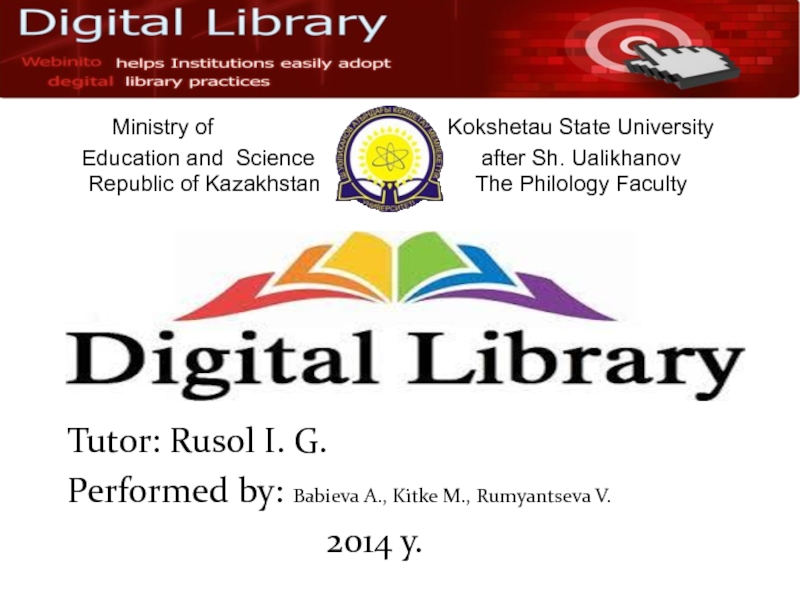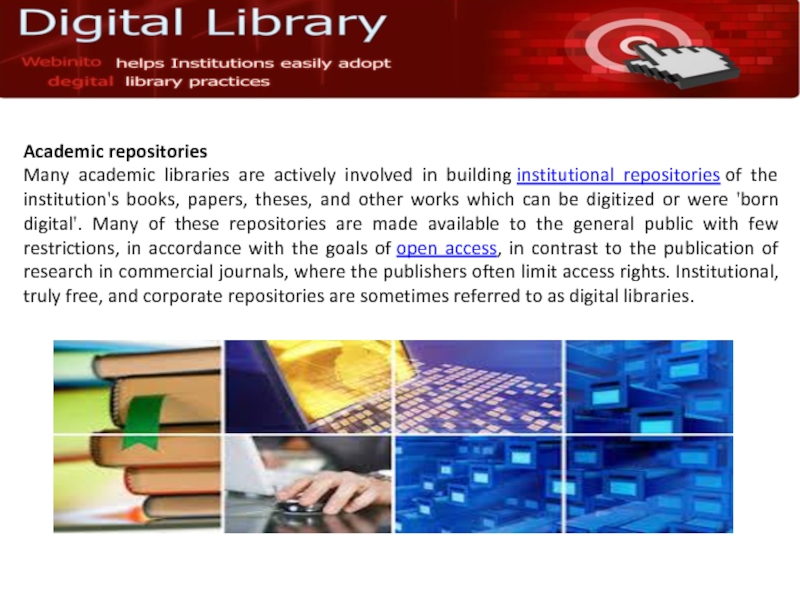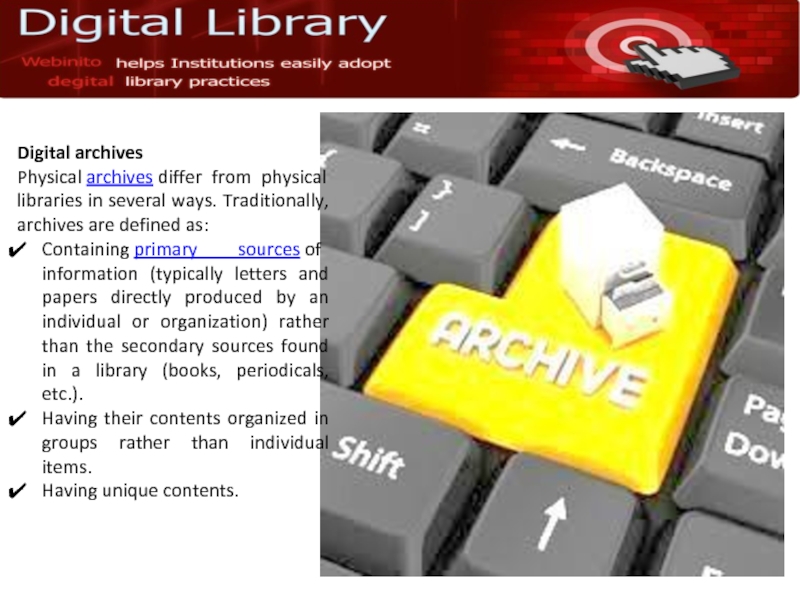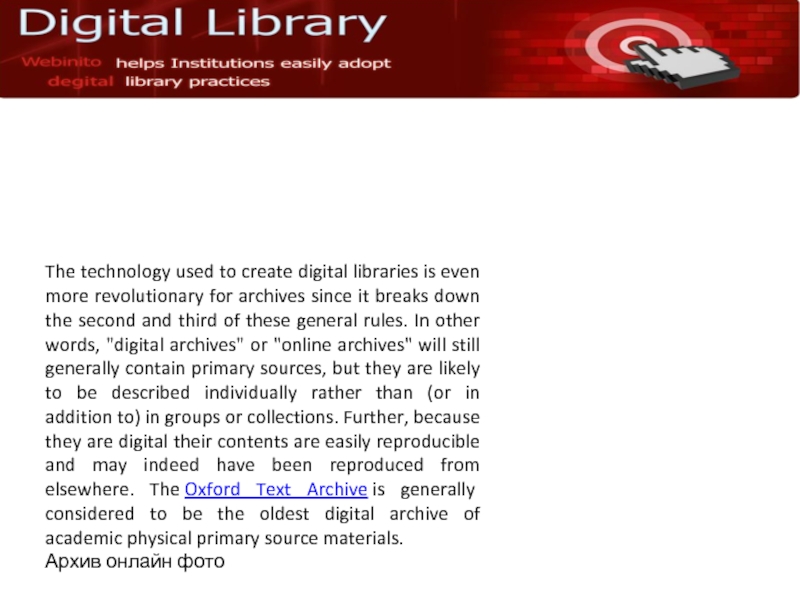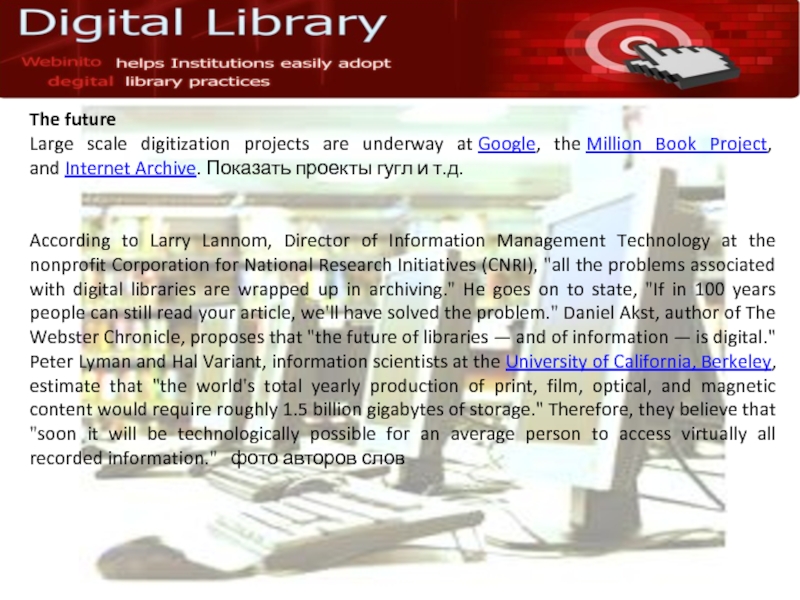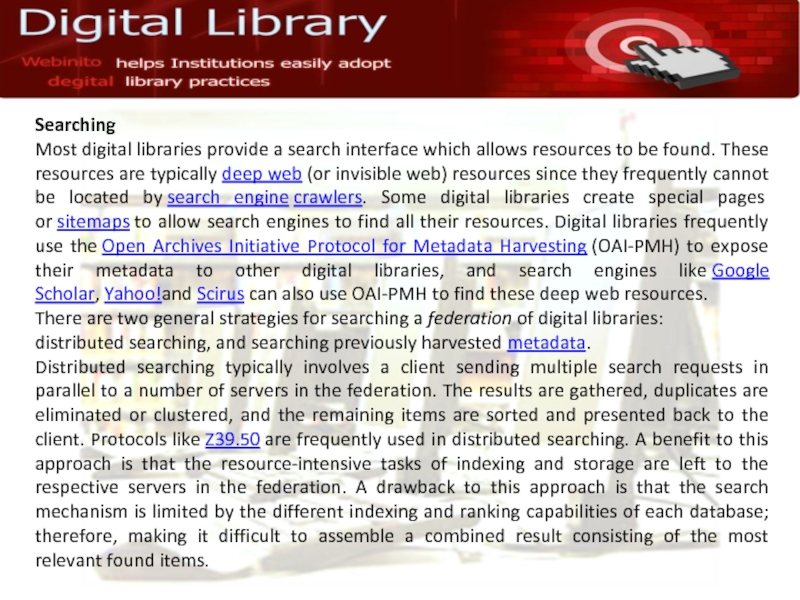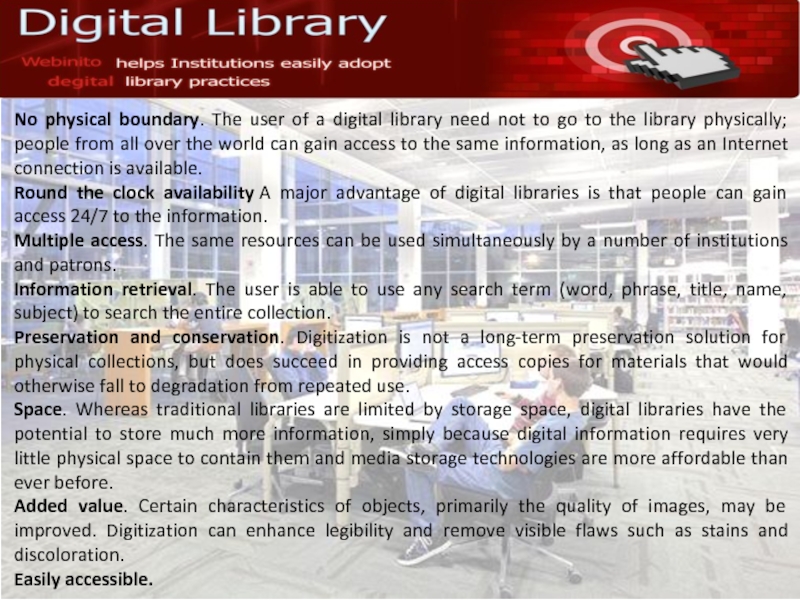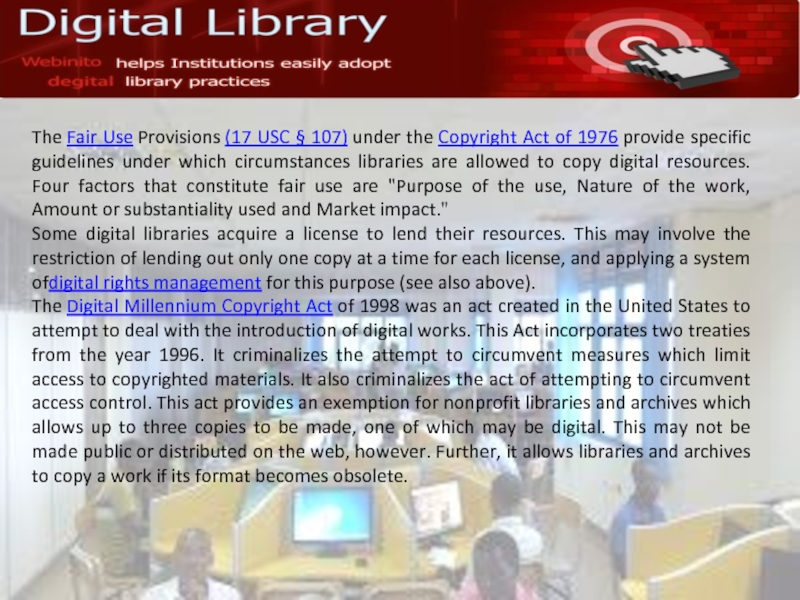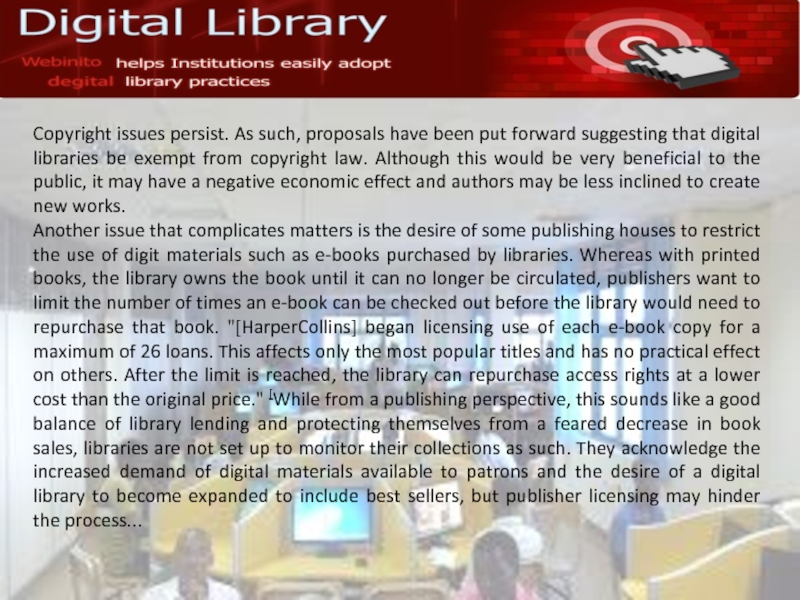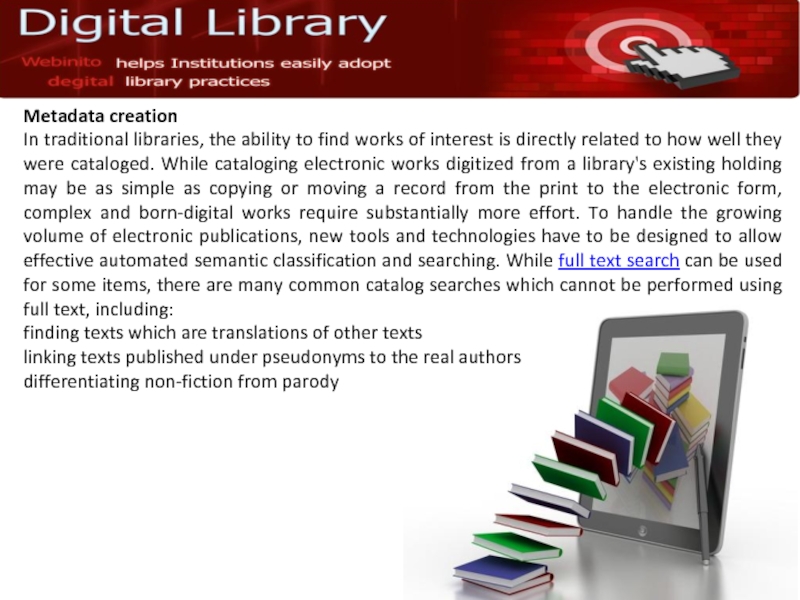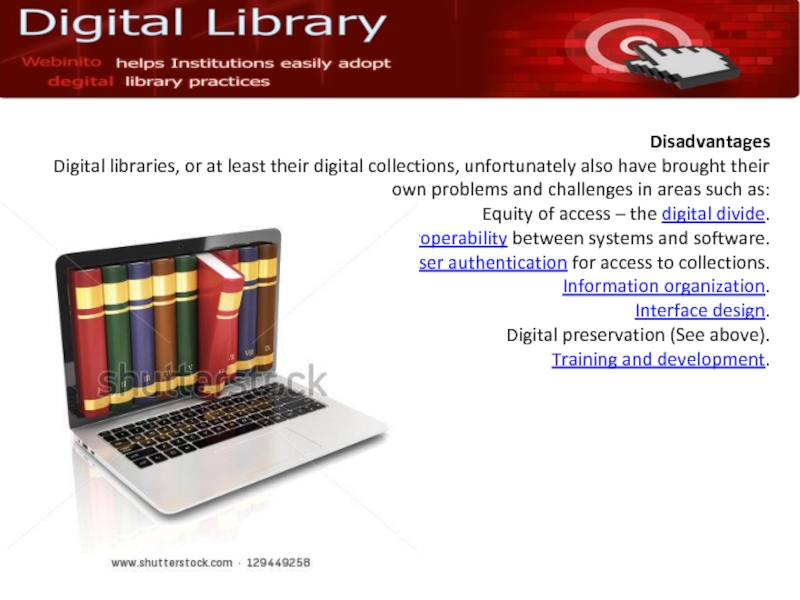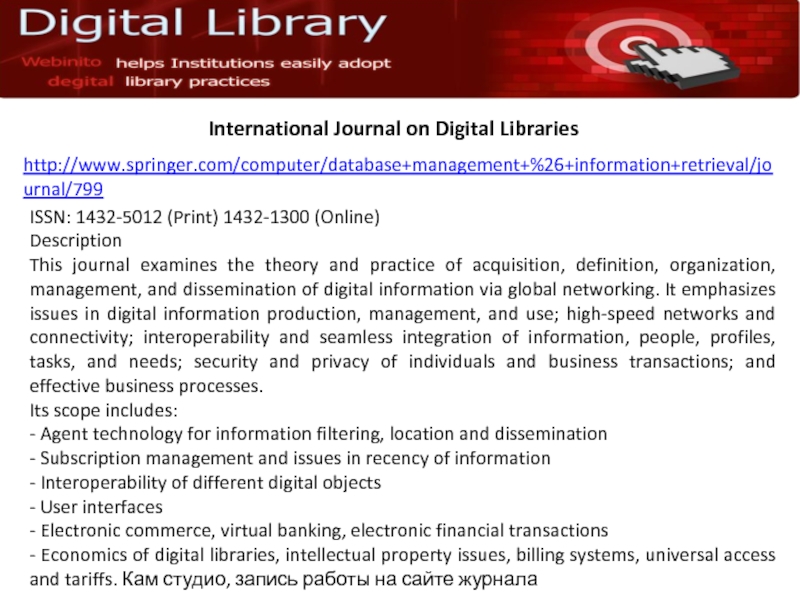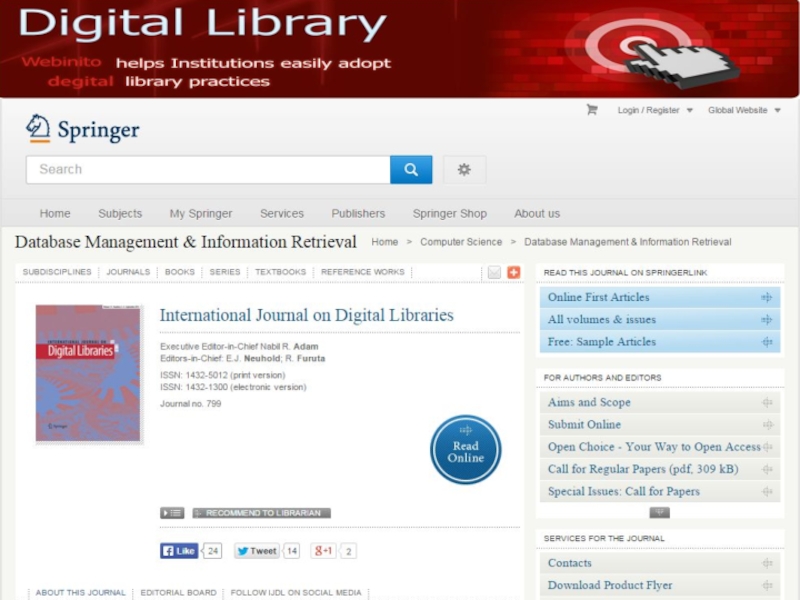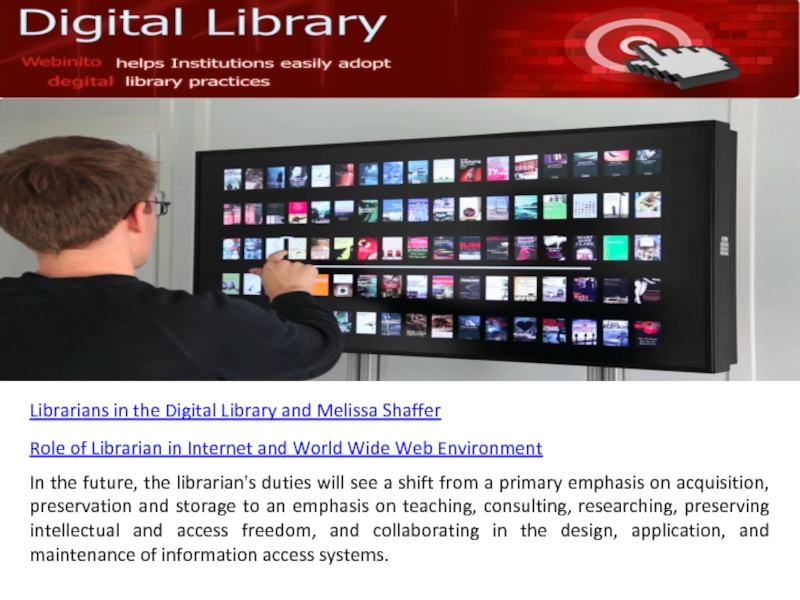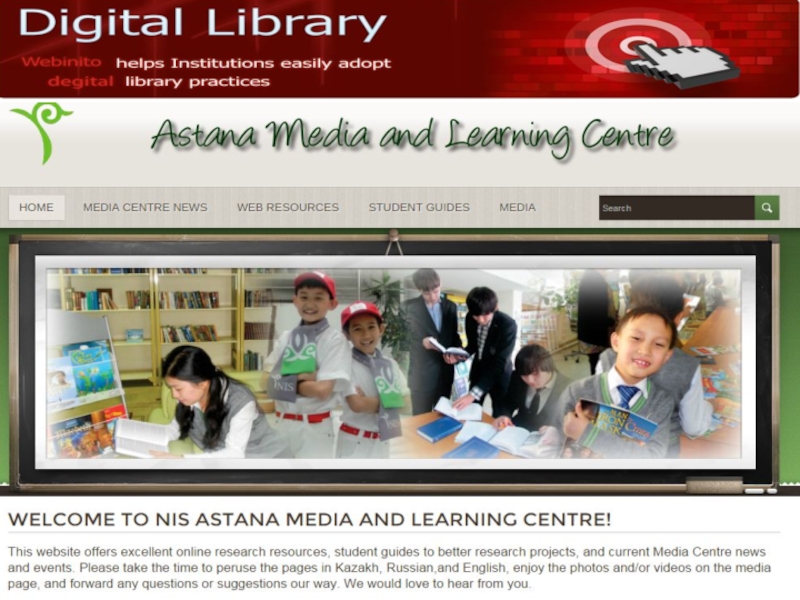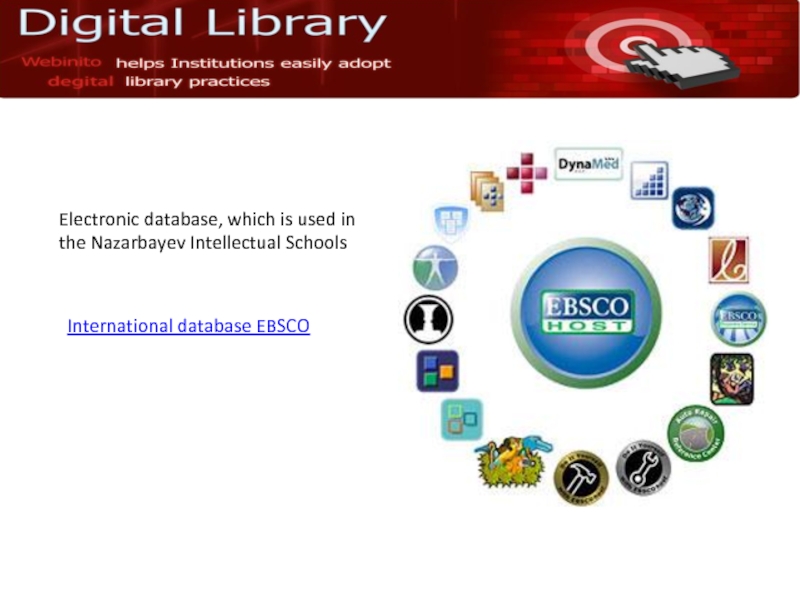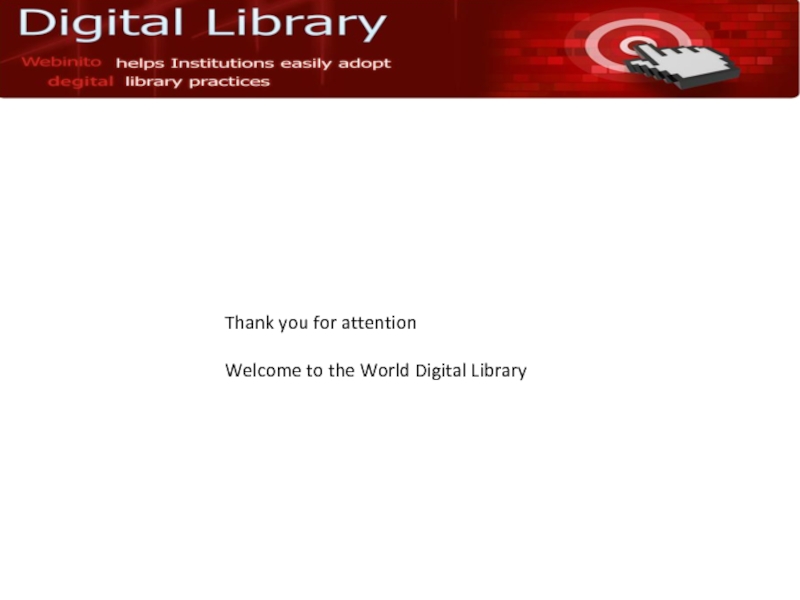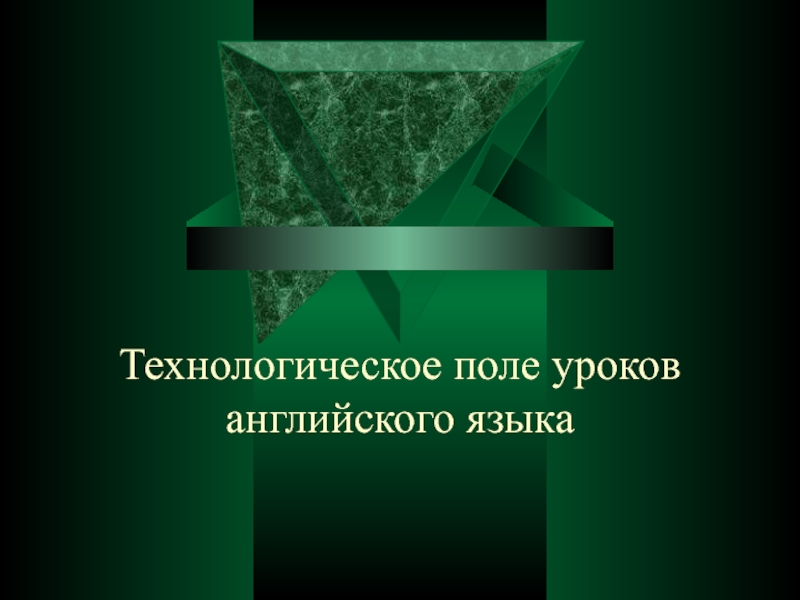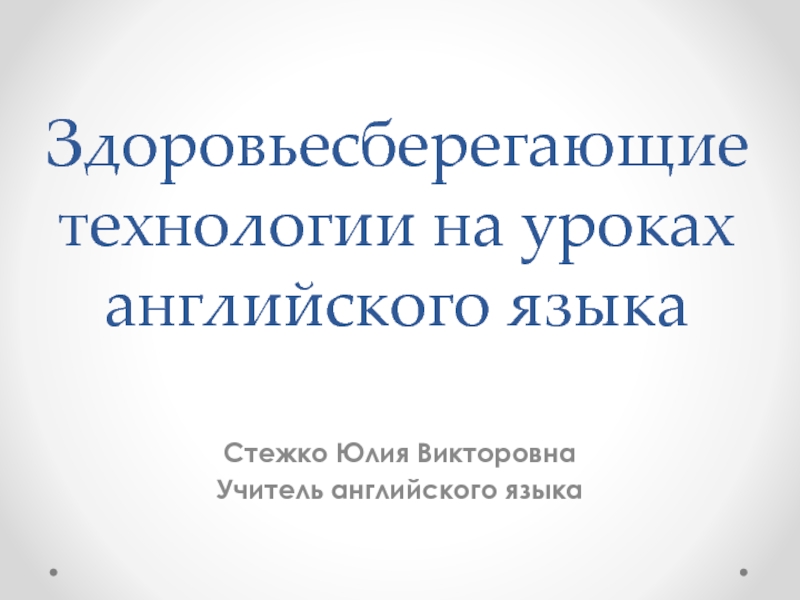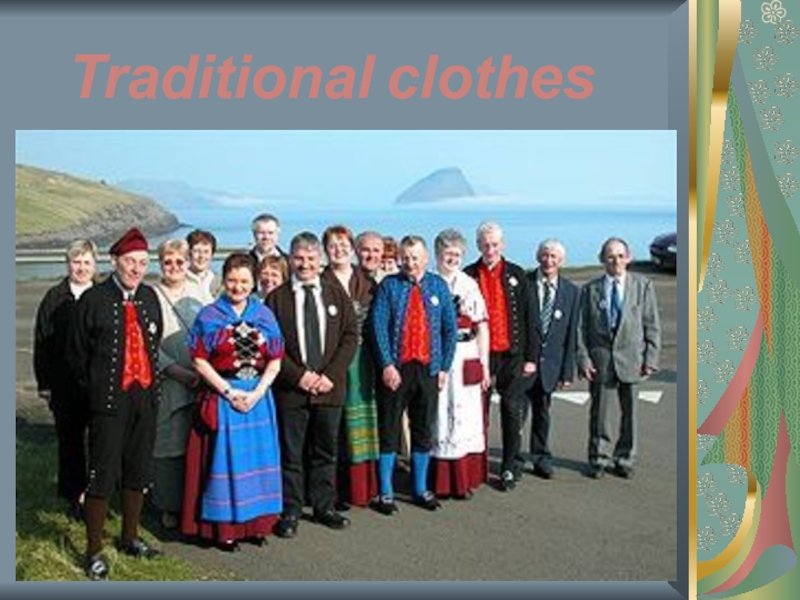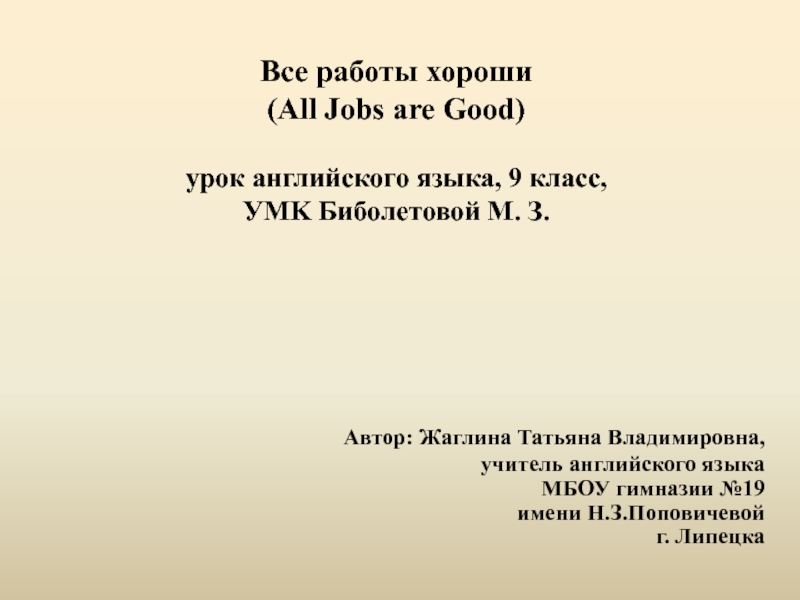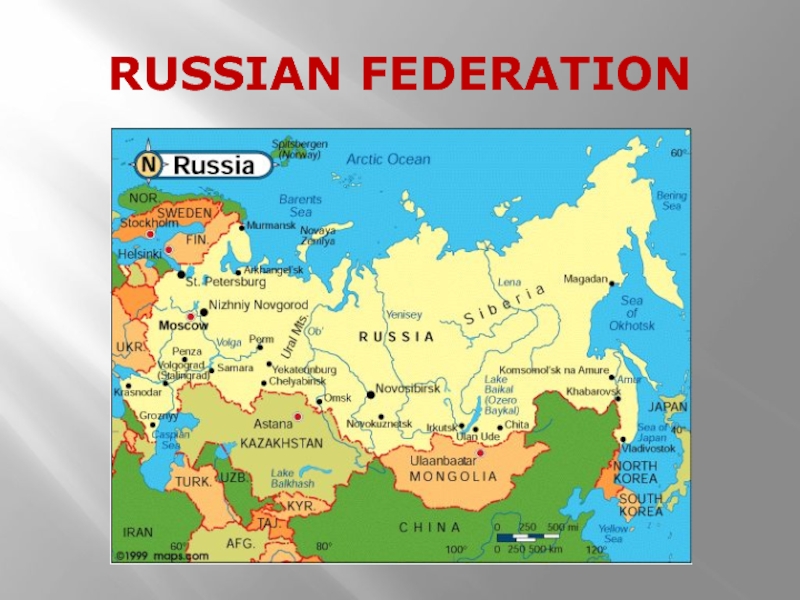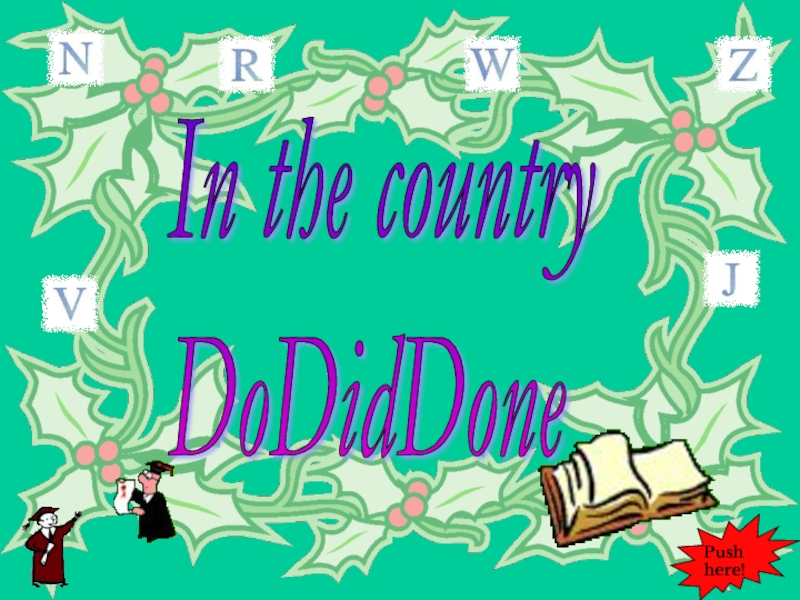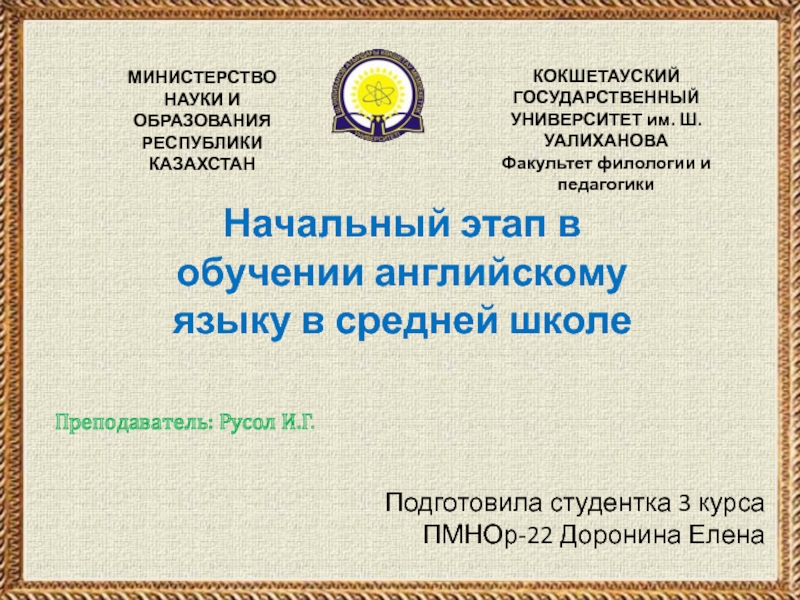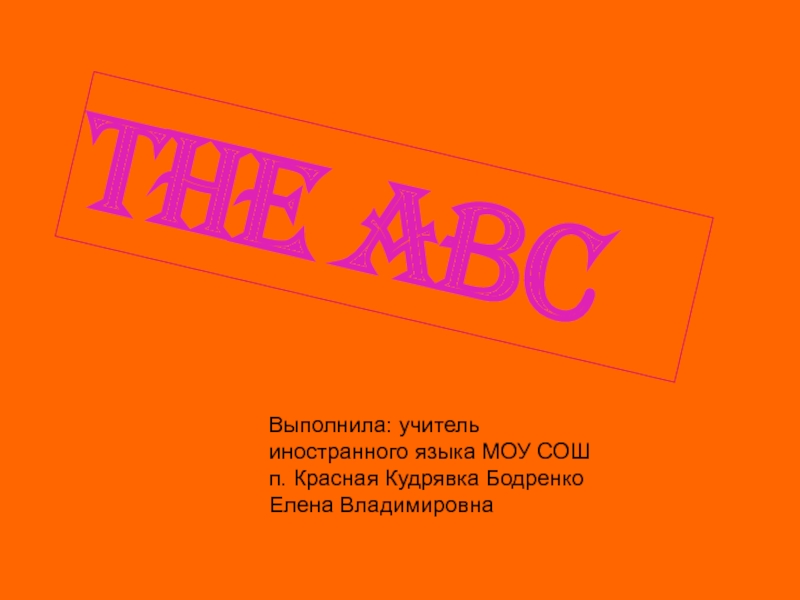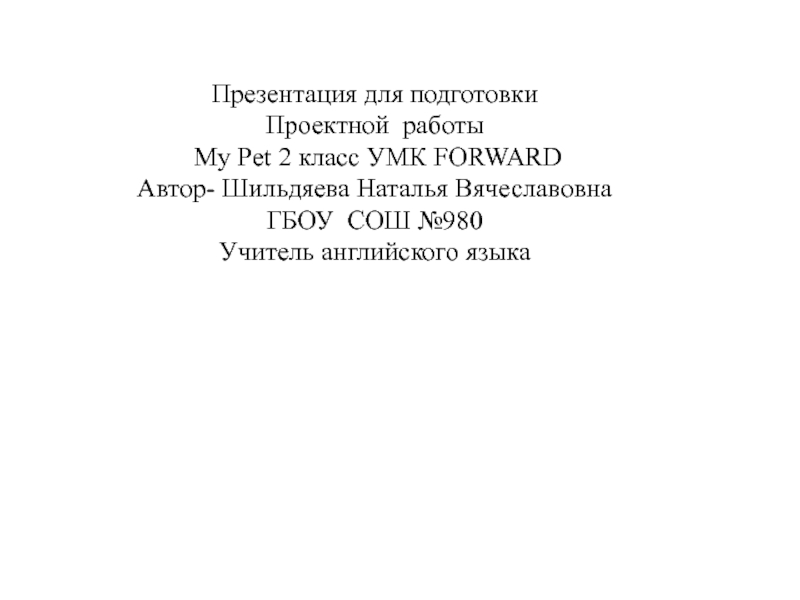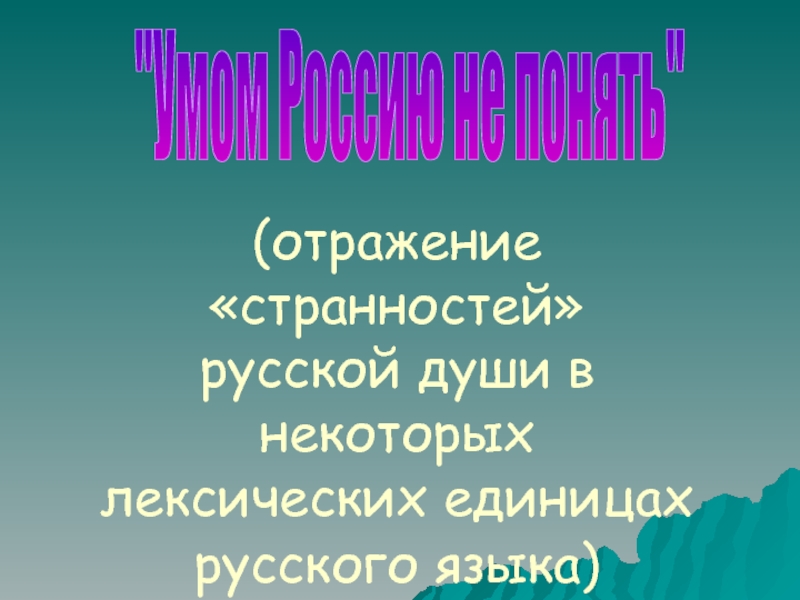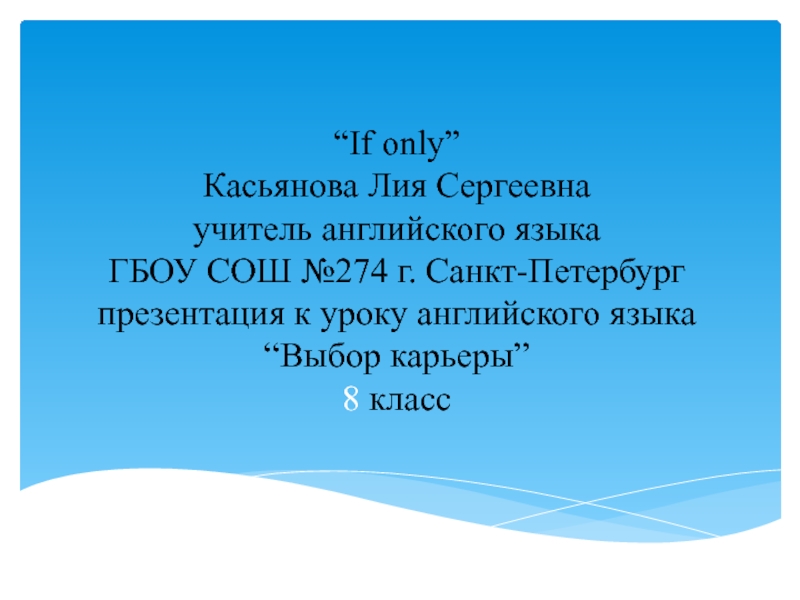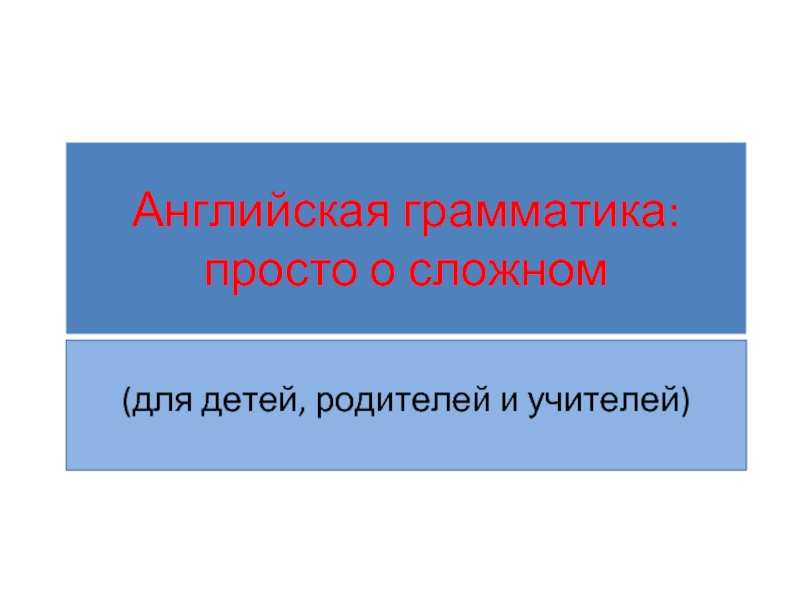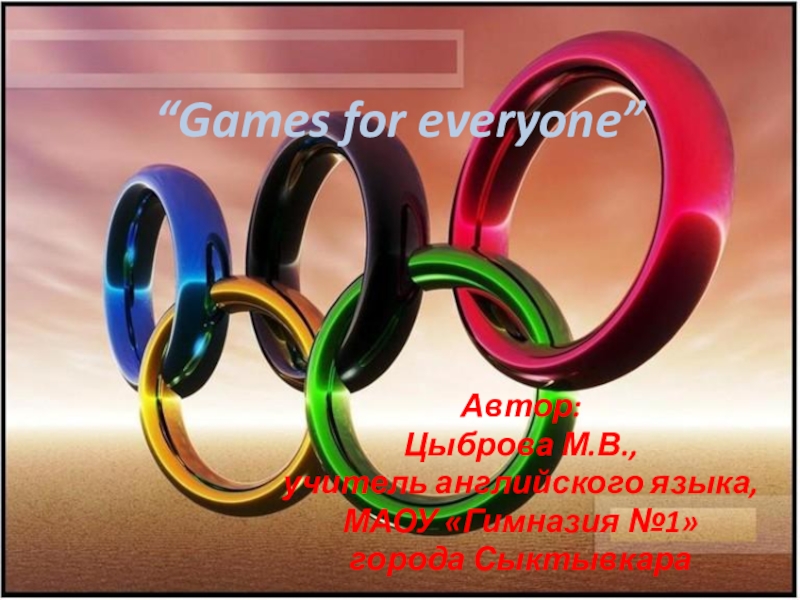Разделы презентаций
- Разное
- Английский язык
- Астрономия
- Алгебра
- Биология
- География
- Геометрия
- Детские презентации
- Информатика
- История
- Литература
- Математика
- Медицина
- Менеджмент
- Музыка
- МХК
- Немецкий язык
- ОБЖ
- Обществознание
- Окружающий мир
- Педагогика
- Русский язык
- Технология
- Физика
- Философия
- Химия
- Шаблоны, картинки для презентаций
- Экология
- Экономика
- Юриспруденция
World digital Library - Examination Project 11 класс
Содержание
- 1. World digital Library - Examination Project 11 класс
- 2. CONTENTS:1 Academic repositories2 Digital archives3 The future4 Searching4.1 Software4.2 Digitization5 Advantages5.1 Digital preservation5.2 Copyright and licensing5.3 Metadata
- 3. Academic repositoriesMany academic libraries are actively involved
- 4. Digital archivesPhysical archives differ from physical libraries in several
- 5. The technology used to create digital libraries
- 6. The futureLarge scale digitization projects are underway
- 7. SearchingMost digital libraries provide a search interface
- 8. Searching over previously harvested metadata involves searching
- 9. SoftwareThere are a number of software packages
- 10. AdvantagesThe advantages of digital libraries as a
- 11. No physical boundary. The user of a
- 12. Digital preservationDigital preservation aims to ensure that
- 13. Copyright and licensingDigital libraries are hampered by copyright law
- 14. The Fair Use Provisions (17 USC § 107) under the Copyright Act
- 15. Copyright issues persist. As such, proposals have
- 16. Metadata creationIn traditional libraries, the ability to
- 17. DisadvantagesDigital libraries, or at least their digital
- 18. International Journal on Digital Librarieshttp://www.springer.com/computer/database+management+%26+information+retrieval/journal/799ISSN: 1432-5012 (Print) 1432-1300 (Online)DescriptionThis
- 19. Слайд 19
- 20. http://www.diglib.org/DLF membership is open to any organization
- 21. In the future, the librarian's duties will
- 22. INTELLECTUAL SCHOOLSSchool of Physics and Mathematics in
- 23. Слайд 23
- 24. International database EBSCOElectronic database, which is used in the Nazarbayev Intellectual Schools
- 25. Thank you for attentionWelcome to the World Digital Library
- 26. Скачать презентанцию
Слайды и текст этой презентации
Слайд 2CONTENTS:
1 Academic repositories
2 Digital archives
3 The future
4 Searching
4.1 Software
4.2 Digitization
5 Advantages
5.1 Digital preservation
5.2 Copyright and licensing
5.3 Metadata creation
6 Disadvantages
7 International Journal
on Digital Libraries
8 Digital Library Federation
9 Librarians in the Digital
Library Слайд 3Academic repositories
Many academic libraries are actively involved in building institutional repositories of
the institution's books, papers, theses, and other works which can
be digitized or were 'born digital'. Many of these repositories are made available to the general public with few restrictions, in accordance with the goals of open access, in contrast to the publication of research in commercial journals, where the publishers often limit access rights. Institutional, truly free, and corporate repositories are sometimes referred to as digital libraries.Слайд 4Digital archives
Physical archives differ from physical libraries in several ways. Traditionally, archives
are defined as:
Containing primary sources of information (typically letters and papers directly
produced by an individual or organization) rather than the secondary sources found in a library (books, periodicals, etc.).Having their contents organized in groups rather than individual items.
Having unique contents.
Слайд 5The technology used to create digital libraries is even more
revolutionary for archives since it breaks down the second and
third of these general rules. In other words, "digital archives" or "online archives" will still generally contain primary sources, but they are likely to be described individually rather than (or in addition to) in groups or collections. Further, because they are digital their contents are easily reproducible and may indeed have been reproduced from elsewhere. The Oxford Text Archive is generally considered to be the oldest digital archive of academic physical primary source materials.Архив онлайн фото
Слайд 6The future
Large scale digitization projects are underway at Google, the Million Book
Project, and Internet Archive. Показать проекты гугл и т.д.
According to Larry
Lannom, Director of Information Management Technology at the nonprofit Corporation for National Research Initiatives (CNRI), "all the problems associated with digital libraries are wrapped up in archiving." He goes on to state, "If in 100 years people can still read your article, we'll have solved the problem." Daniel Akst, author of The Webster Chronicle, proposes that "the future of libraries — and of information — is digital." Peter Lyman and Hal Variant, information scientists at the University of California, Berkeley, estimate that "the world's total yearly production of print, film, optical, and magnetic content would require roughly 1.5 billion gigabytes of storage." Therefore, they believe that "soon it will be technologically possible for an average person to access virtually all recorded information." фото авторов словСлайд 7Searching
Most digital libraries provide a search interface which allows resources
to be found. These resources are typically deep web (or invisible web)
resources since they frequently cannot be located by search engine crawlers. Some digital libraries create special pages or sitemaps to allow search engines to find all their resources. Digital libraries frequently use the Open Archives Initiative Protocol for Metadata Harvesting (OAI-PMH) to expose their metadata to other digital libraries, and search engines like Google Scholar, Yahoo!and Scirus can also use OAI-PMH to find these deep web resources.There are two general strategies for searching a federation of digital libraries:
distributed searching, and searching previously harvested metadata.
Distributed searching typically involves a client sending multiple search requests in parallel to a number of servers in the federation. The results are gathered, duplicates are eliminated or clustered, and the remaining items are sorted and presented back to the client. Protocols like Z39.50 are frequently used in distributed searching. A benefit to this approach is that the resource-intensive tasks of indexing and storage are left to the respective servers in the federation. A drawback to this approach is that the search mechanism is limited by the different indexing and ranking capabilities of each database; therefore, making it difficult to assemble a combined result consisting of the most relevant found items.
Слайд 8Searching over previously harvested metadata involves searching a locally stored index of
information that has previously been collected from the libraries in
the federation. When a search is performed, the search mechanism does not need to make connections with the digital libraries it is searching - it already has a local representation of the information. This approach requires the creation of an indexing and harvesting mechanism which operates regularly, connecting to all the digital libraries and querying the whole collection in order to discover new and updated resources. OAI-PMH is frequently used by digital libraries for allowing metadata to be harvested. A benefit to this approach is that the search mechanism has full control over indexing and ranking algorithms, possibly allowing more consistent results. A drawback is that harvesting and indexing systems are more resource-intensive and therefore expensive.Слайд 9Software
There are a number of software packages for use in
general digital libraries, for notable ones see Digital library software. Institutional
repository software, which focuses primarily on ingest, preservation and access of locally produced documents, particularly locally produced academic outputs, can be found in Institutional repository software. This software may be proprietary, as is the case with the Library of Congress which uses Digiboard and CTS to manage digital content.Digitization
In the past few years, procedures for digitizing books at high speed and comparatively low cost have improved considerably with the result that it is now possible to digitize millions of books per year. Google book-scanning project is also working with libraries to offer digitize books pushing forward on the digitize book realm.
Слайд 10Advantages
The advantages of digital libraries as a means of easily
and rapidly accessing books, archives and images of various types
are now widely recognized by commercial interests and public bodies alike.Traditional libraries are limited by storage space; digital libraries have the potential to store much more information, simply because digital information requires very little physical space to contain it. As such, the cost of maintaining a digital library can be much lower than that of a traditional library. A physical library must spend large sums of money paying for staff, book maintenance, rent, and additional books. Digital libraries may reduce or, in some instances, do away with these fees. Both types of library require cataloging input to allow users to locate and retrieve material. Digital libraries may be more willing to adopt innovations in technology providing users with improvements in electronic and audio book technology as well as presenting new forms of communication such as wikis and blogs; conventional libraries may consider that providing online access to their OP AC catalog is sufficient. An important advantage to digital conversion is increased accessibility to users. They also increase availability to individuals who may not be traditional patrons of a library, due to geographic location or organizational affiliation.
Слайд 11No physical boundary. The user of a digital library need
not to go to the library physically; people from all
over the world can gain access to the same information, as long as an Internet connection is available.Round the clock availability A major advantage of digital libraries is that people can gain access 24/7 to the information.
Multiple access. The same resources can be used simultaneously by a number of institutions and patrons.
Information retrieval. The user is able to use any search term (word, phrase, title, name, subject) to search the entire collection.
Preservation and conservation. Digitization is not a long-term preservation solution for physical collections, but does succeed in providing access copies for materials that would otherwise fall to degradation from repeated use.
Space. Whereas traditional libraries are limited by storage space, digital libraries have the potential to store much more information, simply because digital information requires very little physical space to contain them and media storage technologies are more affordable than ever before.
Added value. Certain characteristics of objects, primarily the quality of images, may be improved. Digitization can enhance legibility and remove visible flaws such as stains and discoloration.
Easily accessible.
Слайд 12Digital preservation
Digital preservation aims to ensure that digital media and
information systems are still interpretable into the indefinite future. Each
necessary component of this must be migrated, preserved or emulated. Typically lower levels of systems (floppy disks for example) are emulated, bit-streams (the actual files stored in the disks) are preserved and operating systems are emulated as a virtual machine. Only where the meaning and content of digital media and information systems are well understood is migration possible, as is the case for office documents. However, at least one organization, the Wider Net Project, has created an offline digital library, the e Granary, by reproducing materials on a 4TB hard drive. Instead of a bit-stream environment, the digital library contains a built-in proxy server and search engine so the digital materials can be accessed using an Internet browser. Also, the materials are not preserved for the future. The e Granary is intended for use in places or situations where Internet connectivity is very slow, non-existent, unreliable, unsuitable or too expensive.Слайд 13Copyright and licensing
Digital libraries are hampered by copyright law because, unlike with
traditional printed works, the laws of digital copyright are still
being formed. The republication of material on the web by libraries may require permission from rights holders, and there is a conflict of interest between libraries and the publishers who may wish to create online versions of their acquired content for commercial purposes. In 2010, it was estimated that twenty-three percent of books in existence were created before 1923 and thus out of copyright. Of those printed after this date, only five percent were still in print as of 2010. Thus, approximately seventy-two percent of books were not available to the public.There is a dilution of responsibility that occurs as a result of the distributed nature of digital resources. Complex intellectual property matters may become involved since digital material is not always owned by a library. The content is, in many cases, public domain or self-generated content only. Some digital libraries, such as Project Gutenberg, work to digitize out-of-copyright works and make them freely available to the public. An estimate of the number of distinct books still existent in library catalogues from 2000 BC to 1960, has been made.
Слайд 14The Fair Use Provisions (17 USC § 107) under the Copyright Act of 1976 provide specific
guidelines under which circumstances libraries are allowed to copy digital
resources. Four factors that constitute fair use are "Purpose of the use, Nature of the work, Amount or substantiality used and Market impact."Some digital libraries acquire a license to lend their resources. This may involve the restriction of lending out only one copy at a time for each license, and applying a system ofdigital rights management for this purpose (see also above).
The Digital Millennium Copyright Act of 1998 was an act created in the United States to attempt to deal with the introduction of digital works. This Act incorporates two treaties from the year 1996. It criminalizes the attempt to circumvent measures which limit access to copyrighted materials. It also criminalizes the act of attempting to circumvent access control. This act provides an exemption for nonprofit libraries and archives which allows up to three copies to be made, one of which may be digital. This may not be made public or distributed on the web, however. Further, it allows libraries and archives to copy a work if its format becomes obsolete.
Слайд 15Copyright issues persist. As such, proposals have been put forward
suggesting that digital libraries be exempt from copyright law. Although
this would be very beneficial to the public, it may have a negative economic effect and authors may be less inclined to create new works.Another issue that complicates matters is the desire of some publishing houses to restrict the use of digit materials such as e-books purchased by libraries. Whereas with printed books, the library owns the book until it can no longer be circulated, publishers want to limit the number of times an e-book can be checked out before the library would need to repurchase that book. "[HarperCollins] began licensing use of each e-book copy for a maximum of 26 loans. This affects only the most popular titles and has no practical effect on others. After the limit is reached, the library can repurchase access rights at a lower cost than the original price." [While from a publishing perspective, this sounds like a good balance of library lending and protecting themselves from a feared decrease in book sales, libraries are not set up to monitor their collections as such. They acknowledge the increased demand of digital materials available to patrons and the desire of a digital library to become expanded to include best sellers, but publisher licensing may hinder the process...
Слайд 16Metadata creation
In traditional libraries, the ability to find works of
interest is directly related to how well they were cataloged.
While cataloging electronic works digitized from a library's existing holding may be as simple as copying or moving a record from the print to the electronic form, complex and born-digital works require substantially more effort. To handle the growing volume of electronic publications, new tools and technologies have to be designed to allow effective automated semantic classification and searching. While full text search can be used for some items, there are many common catalog searches which cannot be performed using full text, including:finding texts which are translations of other texts
linking texts published under pseudonyms to the real authors
differentiating non-fiction from parody
Слайд 17Disadvantages
Digital libraries, or at least their digital collections, unfortunately also
have brought their own problems and challenges in areas such
as:Equity of access – the digital divide.
Interoperability between systems and software.
User authentication for access to collections.
Information organization.
Interface design.
Digital preservation (See above).
Training and development.
Слайд 18International Journal on Digital Libraries
http://www.springer.com/computer/database+management+%26+information+retrieval/journal/799
ISSN: 1432-5012 (Print) 1432-1300 (Online)
Description
This journal examines the
theory and practice of acquisition, definition, organization, management, and dissemination
of digital information via global networking. It emphasizes issues in digital information production, management, and use; high-speed networks and connectivity; interoperability and seamless integration of information, people, profiles, tasks, and needs; security and privacy of individuals and business transactions; and effective business processes.Its scope includes:
- Agent technology for information filtering, location and dissemination
- Subscription management and issues in recency of information
- Interoperability of different digital objects
- User interfaces
- Electronic commerce, virtual banking, electronic financial transactions
- Economics of digital libraries, intellectual property issues, billing systems, universal access and tariffs. Кам студио, запись работы на сайте журнала
Слайд 20http://www.diglib.org/
DLF membership is open to any organization engaged in building
or using digital libraries, including archives, libraries and library service
organizations, publishers, museums, and vendors. Members are expected to contribute to community efforts through a variety of research and development, information sharing, and catalytic initiatives. Members may participate in workgroups, such as the project managers group; committees, such as an outreach and communications committee; or they may support the Forum by contributing to the program when appropriate, and sending personnel from the organization who will actively participate. Members will will also have special opportunities to contribute to other events or programs.MembershipHighlights
Discounted Forum registration
Travel award and fellowship opportunities
Complimentary job postings
Workgroups and affiliated resources
DLF communications and outreach support via Twitter, Facebook, DLF-Announce listserv, and our website
Support of the digital library community
AnnualInvestment
The fee for membership is $6,000 per year. Any institution that is also a CLIR sponsor receives a discounted fee of $4,500. The membership year runs from July 1-June 30; for any member joining after July, annual dues will be prorated accordingly.
Please contact Louisa Kwasigroch if you are interested in becoming a DLF member.
Слайд 21In the future, the librarian's duties will see a shift
from a primary emphasis on acquisition, preservation and storage to
an emphasis on teaching, consulting, researching, preserving intellectual and access freedom, and collaborating in the design, application, and maintenance of information access systems.Role of Librarian in Internet and World Wide Web Environment
Librarians in the Digital Library and Melissa Shaffer
Слайд 22INTELLECTUAL SCHOOLS
School of Physics and Mathematics in Astana
Nazarbayev Intellectual school
in Astana
School of Physics and Mathematics in Kokshetau
School of Physics
and Mathematics in TaldykorganSchool of Physics and Mathematics in Semey
School of Physics and Mathematics in Uralsk
School of Chemistry and Biology in Ust-Kamenogorsk
School of Physics and Mathematics in Aktobe
School of Chemistry and Biology in Karaganda
School of Chemistry and Biology in Shymkent
School of Physics and Mathematics in Shymkent
School of Physics and Mathematics in Taraz
School of Chemistry and Biology in Kyzylorda
School of Chemistry and Biology in Pavlodar
School of Chemistry and Biology in Atyrau
School of Physics and Mathematics in Almaty
